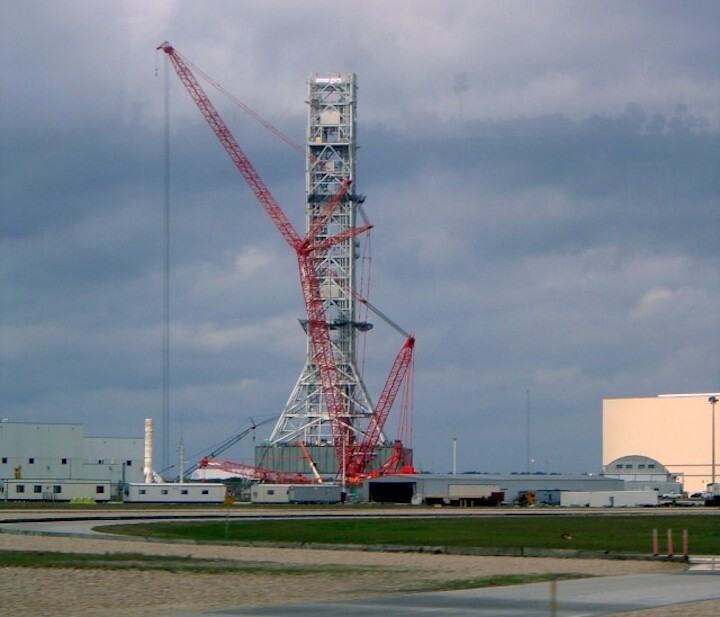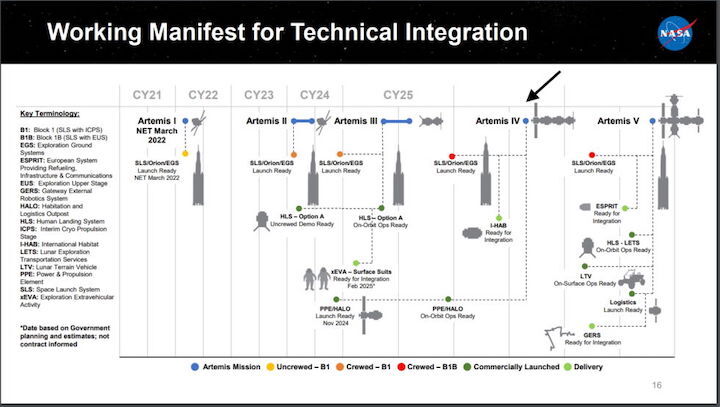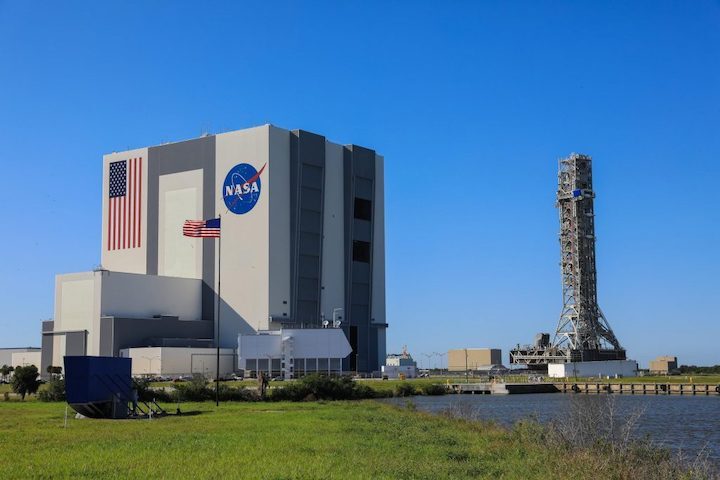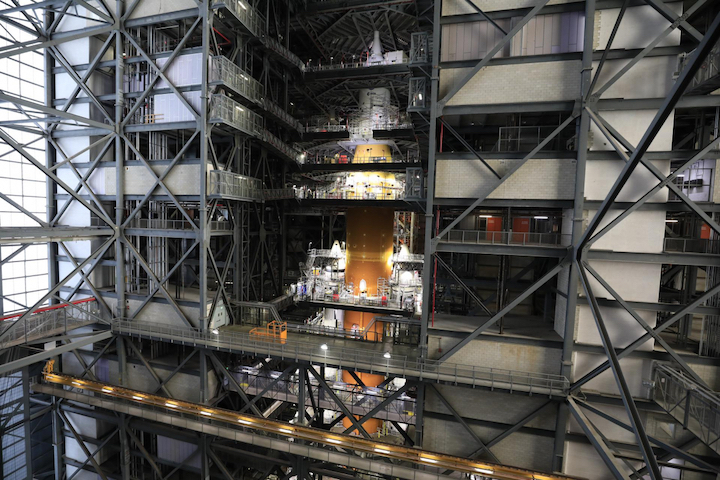30.01.2022
Another launch tower built for the SLS rocket has “encountered some challenges”

Crews working on an Ares launch tower in February 2010 at the Kennedy Space Center, even after Constellation had been informally canceled. This would eventually become Mobile Launcher-1.
The Space Launch System rocket that NASA has been building for more than a decade now—and which may finally launch for the first time this spring or summer—is rather big. And big rockets need large, complicated ground systems to fuel them and support their launch.
As one might imagine, for a rocket as expensive as the SLS booster—development so far has run in excess of $20 billion and counting—its associated ground systems are quite costly as well.
Much has already been said and written about the first "mobile launch tower" built for the SLS rocket. The massive, rolling Mobile Launcher-1 supports the 108-meter-tall SLS rocket, provides access to the Orion spacecraft, and supplies power, communications, coolant, and fuel to the rocket. Over a decade, NASA spent about $1 billion to build, redesign, and then complete the structure under a cost-plus contract.
Now, as early as next month, this launch tower will be put to the test as it rolls the SLS rocket to a launch pad at Kennedy Space Center in Florida and the booster is fueled during what is known as a "wet dress rehearsal." At that point, we'll know whether the tower works.
But even though NASA has not yet launched the SLS rocket or shown its capabilities, Congress has already been insistent that the agency develop a larger and more capable version. This "Block 1B" version of the SLS will have a larger and more powerful upper stage. Because this cannot be accommodated by the Mobile Launcher-1, a new launch tower is needed. (That's right—NASA is going to spend $1 billion for some launch infrastructure, Mobile Launcher-1, that may be used just two or three times.)
Earlier, Bechtel National, of Reston, Virginia, won this contract to design and build the second larger mobile launcher for $383 million by March 2023. Commenting on this development two years ago, Ars Technica wrote, "This would be for about one-third the cost of the first mobile launcher in half the time. Past performance would suggest this is unlikely." That statement has now been proven to be correct.
On Thursday, during a meeting of NASA's Aerospace Safety Advisory Panel, one of its members provided an update on Mobile Launcher-2. George Nield, an engineer and scientist who previously led commercial space transportation for the Federal Aviation Administration, said the 90-percent design, review, and fabrication drawings for the large structure are behind schedule. These are the engineering drawings that should closely represent the final design and inform a construction schedule and logistics plan.
"Mobile Launcher-2 has encountered some challenges," Nield said. "The selected contractor, Bechtel, has experienced some performance issues associated with underestimating the complexity of the project and some supplier related issues, as well as COVID."
As a result, Nield said, NASA has issued a "second letter of concern" to Bechtel requesting an assessment of project risks and impediments, plus a corrective action plan, as well as an identification of opportunities to reduce costs and mitigate schedule disruptions while improving efficiency. This plan is due back to NASA next Tuesday. "So NASA is in the process of evaluating changes to the contract structure and program management to address some of those issues," Nield said.
We should get some more clarity on all of these issues later this year, as NASA's Office of Inspector General has said it is looking into the development of Mobile Launcher-2. "Our newest audit will examine if the ML-2 contract is meeting cost, schedule, and performance goals," the inspector general said on Twitter.
In reality, a mobile launch tower is an incredibly complex piece of infrastructure. It must be sturdy enough to support a rocket launch and complex enough to fuel and power the vehicle on the ground. So it's understandable that the project will run into engineering challenges.
And at this point, who really cares if there are delays? Not the people who matter. For parochial policy reasons, Congress is committed to spending hundreds of millions of dollars a year to support a ground systems workforce in Florida. NASA Administrator Bill Nelson is a former US senator from Florida, and he's going to back any spending in his state. NASA's associate administrator, Bob Cabana, is the former director of Kennedy Space Center. He may well use this as an opportunity to increase funding for ground systems in Florida.

This chart is from a recent NASA presentation. We've added a black arrow to indicate when Mobile Launcher-2 is needed.
Moreover, the "Block 1B" version of the SLS rocket is years away from launch. Boeing is developing the rocket's Exploration Upper Stage, and that project is unlikely to be completed before the mid-2020s. During a recent presentation to the agency's advisory committee, NASA's exploration officials said they would not need the Block 1B version of the SLS rocket until the "Artemis 4" mission to the Moon, which probably will not launch before 2027 or 2028. The dates for such a mission are so notional that NASA did not even include them on its chart.
So if the Mobile Launcher-2 is a few years late and a few hundred million dollars over budget, it probably doesn't matter to NASA's leadership. Even if it should.
Quelle: arsTechnica
----
Update: 3.02.2022
.
Artemis I Update

NASA has updated the schedule to move the combined Space Launch Systemrocket and Orion spacecraft out of the Vehicle Assembly Building (VAB) to Launch Pad 39B at the agency’s Kennedy Space Center in Florida for testing to no earlier than March 2022.
NASA has added additional time to complete closeout activities inside the VAB prior to rolling the integrated rocket and spacecraft out for the first time. While the teams are not working any major issues, engineers continue work associated with final closeout tasks and flight termination system testing ahead of the wet dress rehearsal.
Teams are taking operations a step at a time to ensure the integrated system is ready to safely launch the Artemis I mission. NASA is reviewing launch opportunities in April and May.
Quelle: NASA
----
Update: 18.02.2022
.
Artemis 1 rollout timing remains uncertain as NASA leadership deliberates the schedule

The first rollout of NASA’s first integrated Orion and Space Launch System (SLS) vehicle for Artemis 1 is now tentatively targeted for mid-March, but the schedule towards that milestone and eventual attempts to launch the vehicle are shrouded in uncertainty. In early February, the space agency announced another multi-week delay in the planned date for rolling the vehicle out to the launch pad, from mid-February to sometime in the mid-March time frame.
The team at the Kennedy Space Center (KSC) in Florida led by the Exploration Ground Systems (EGS) program is wrapping up integrated testing in the Vehicle Assembly Building (VAB) and closing out the vehicle for a final Wet Dress Rehearsal (WDR) countdown demonstration test and launch. Still, agency leadership and management from the EGS, Orion, and SLS programs continue discussions about what dates to target for those milestones.
A mid-March rollout for the WDR test probably puts an April launch for Artemis 1 out of reach and preparations and program reviews are more likely to stretch farther into the Spring towards the Summer as NASA moves slowly and deliberately towards final readiness to launch.
Ground operations finishing up final tests and closeouts
After a three-week delay in the next major milestone was made public on February 1, NASA confirmed the news the next day. “NASA has updated the schedule to move the combined Space Launch System rocket and Orion spacecraft out of the Vehicle Assembly Building (VAB) to Launch Pad 39B at the agency’s Kennedy Space Center in Florida for testing to no earlier than March 2022,” a short February 2 post said.
Just the week before, a second run of a countdown sequence test was completed and preparations by EGS and prime launch processing contractor Jacobs were said to be progressing towards rolling out the Artemis 1 vehicle from the VAB to Pad 39B in mid-February. This is the first time an Orion-SLS vehicle has been integrated for launch and NASA is planning a final, full launch countdown demonstration test at the pad before declaring that the programs, the hardware, and the team are ready to attempt to launch Artemis 1.
EGS and Jacobs are working with the Orion and SLS Programs and their contractors on completing final configurations and integrated testing prior to rolling out to the pad for the countdown test, which is called a Wet Dress Rehearsal (WDR). Flight Termination System (FTS) component installation and testing is the last major series of tests that need to be completed before rollout; running and securing cables inside the forward skirts of the two SLS Solid Rocket Boosters (SRB) for some of the development flight instrumentation (DFI) was one of the tasks that was delaying the start of the FTS work.

Artemis 1 at the launch pad. (Credit: NASA)
“The DFI [is] inside the forward skirt of the boosters; we had to finish that routing in order to get into the FTS testing,” Cliff Lanham, NASA Senior Vehicle Operations manager for EGS at KSC, said in an interview on February 8. “That work is done but that was some of the DFI work that they were referring to at the time [of the early February delay] that needed to be completed.”
Final installs and configuration of the FTS are being done in two parts — one part before the WDR test and one part after — just ahead of launch. “On the FTS testing, we did complete the ICPS (Interim Cryogenic Propulsion Stage) portion last week,” Lanham noted. Now that the SRB instrumentation work that needed to be completed before FTS testing is finished, Lanham said the team is pressing onto the rest of the work.
“We powered up Monday (February 7) [and] we got into our initial checks and all went well there,” he said. “We are today installing ordnance and that’ll run through tomorrow (February 9). It’s all considered part of the testing.” The pre-WDR part of the flight termination system was expected to be completed this week (the week of February 14) but will depend on the resolution of issues during the testing and checkout of those components and the overall subsystem.
Although some work schedules reflect a no-earlier-than (NET), March 8 date for the first rollout to the pad, upper management at NASA Headquarters in Washington, D.C. will ultimately decide when the rollout occurs. During a briefing with the media by telephone on February 2, agency leadership indicated that they were targeting rollout in mid-March.
“We’re making good progress towards a mid-March rollout and notwithstanding some issue that pops up I think we’re in very good shape meeting a mid-March date,” Lanham said. “From a program and ESD (Exploration Systems Development) and Headquarters standpoint, they’re talking constantly to identify what that date will be, so I really can’t speak to that in terms of when they would announce that date and settle on the actual date at this point.”
“[My focus is] to get the vehicle and the Mobile Launcher ready to go.”

Credits: NASA/Cory Huston and NASA.
(Photo Caption: In the main image, the four Core Stage RS-25 engines are seen on January 10 in the VAB. Parts of the engine powerheads were still exposed at the time while final checkouts were being completed; since then, the engine-mounted heat shield (EMHS) flight blankets have been installed; inset in the bottom right, a set of blankets can be seen installed on the Core Stage during earlier Green Run testing at Stennis Space Center.)
In terms of the remaining work on the flight and ground hardware prior to rollout, Lanham said: “Right now what I would call a critical path would be finishing up [the pre-WDR flight termination system work] and then getting into the [Core Stage] intertank closeouts, then the [SRB] forward skirt closeouts, and then the confidence checks of those areas and then we get up into our rollout preps for the ML (Mobile Launcher) and the VAB.”
The first roll of the vehicle to Pad 39B will be for multiple weeks of testing on the pad, which revolve around the WDR. The test involves a full, pre-launch timeline at the pad, including a full launch countdown sequence.
On the simulated launch day of the WDR, both cryogenic, liquid rocket stages of the SLS vehicle, the Core Stage and the ICPS will be loaded with liquid hydrogen (LH2) and liquid oxygen (LOX). The WDR is not just a tanking test, however; the automated countdown sequence will be run all the way from tanking through the final ten-minute terminal countdown all the way until moments before the Core Stage engines would be commanded to start.
The test will verify that all the ground and flight hardware and computer software between them are ready to support committing the SLS vehicle and Orion spacecraft to one of the agency’s highest stakes missions in years.
While upper management deliberates on schedule paths, the Integrated Operations team is also continuing to wrap up vehicle closeouts in the VAB. Other work on the left and right SRBs that remains to be completed are final thermal protection system (TPS) work, inspections, and closeouts.
“Right now, there’s not a whole lot of [forward work] from a Booster standpoint,” Lanham said. “We’re completing what we call RT-455 application, which is basically a TPS ablative material. We’re wrapping that up on both sides and that basically fills the channels that DFI cable runs in [with the material] to protect it.”
RT-455 is a room temperature vulcanizing (RTV) material that is applied to exterior seams as a weather seal and for thermal protection. “We’re very close to wrapping that [RT-455 work] up, and then you’ve got to go inspect that and potentially sand that down to meet the requirement,” Lanham explained.
“[On the] Core Stage attach ring covers, we’re finalizing the installs of those. We have work to do at the crossover point between the Booster and the Core Stage and some of that work can’t be completed until after the FTS testing. Thermal curtain installations on the aft skirts will [also] need to be completed, so that kind of gives a flavor of what all is left on the boosters.”
Closeouts on the Core Stage itself are reaching their final phases. “The Core Stage engine blankets are installed, so that work is complete,” Lanham noted.
“We’re [now] performing inspections and closeouts, we’ve completed the upper portion of the engine section and we’re into the lower portion of the engine section, so when that’s completed we’ll pull the access platforms out of [the engine section] and that area will be complete. And then following the FTS testing, we have to closeout the intertank and forward skirt volumes.”
The ICPS in-space, second stage for SLS and the Launch Vehicle Stage Adapter (LVSA) it is stacked on are also going through similar final inspections and closeouts. “On the LVSA, once we completed the ICPS portion of the FTS, we did a hazardous gas characterization test of that volume and then right now we’re putting in the lower access volumes to be able to get into our closeouts and finalize the LVSA area,” Lanham said.
“With ICPS it’s really down to closeout work for the most part to finish that up and get that area ready and then we’ll do a confidence check of that volume and we’ll be pretty much ready [for rollout].”

Credit: Stephen Marr for NSF.
(Photo Caption: The Core Stage intertank is seen flanked by the forward skirts of the two Solid Rocket Boosters in VAB High Bay 3 on December 20. Access inside those three areas is needed to perform final installations of Flight Termination System components and verification that the safety system is fully functional. Testing inside the intertank and forward skirts will be one of the final tasks in the VAB before the Artemis 1 vehicle rolls out to the pad, prior to both the Wet Dress Rehearsal and launch.)
Meanwhile, final rollout preparations for Orion were also being completed. “With Orion, basically we had some non-conformances that we’re finishing up and we had some [instrumentation] cable routing and then it’s basically closeout operations,” Lanham said.
“[To] kind of give you a flavor of that, there’s some cables that have to be demated inside Orion [and] there’s some closeouts on the inside that we have to do. Then we have to close the CM (Crew Module) hatch, there’s a purge barrier fit check to perform, and then [we] close the LAS (Launch Abort System) hatch and Orion will be in pretty good shape to support the rollout and the WDR.”
Outside the work in the VAB, the EGS, Orion, and SLS programs are also working to update and complete engineering documentation ahead of the launch. The disposition and closure of past and present issues uncovered during testing is one of the activities that needs to be completed ahead of the upcoming major milestones like rollout, WDR, and launch. The issues are called “non-conformances,” abbreviated as NCs.
“You always want to make sure you have your paper closed out as much as you can before you roll out for a major test like this, so we have teams working to get that paper identified and closed,” Lanham said. “In some cases, maybe an NC was picked up on a previous test and there’s some engineering [analysis] that needs to be developed to close out the NC.”
“That’s a case of a paper NC and then you have some other NCs that require some hands-on work to the vehicle. So teams are off working the paper aspect and it’s running in parallel with the fieldwork.”
Issues that impact the work in the VAB or require additional work there were prioritized and Lanham noted that “the hands-on part of that is identified and in our schedule at this point.”
Agency deliberating launch considerations
Following the WDR and completion of other special engineering tests that need to be completed while outdoors at the launch pad, the vehicle will be safed and rolled back to the VAB. NASA changed their concept of launch operations from the Space Shuttle to SLS; most pre-launch servicing and maintenance is planned to be performed in the VAB rather than out at the launch pad, as much of the pre-launch work was for Shuttle.

Credit: NASA.
(Photo Caption: The current earliest monthly launch opportunities are shown in this edited mission availability calendar that was acquired through an independent FOIA request. Launch period 20 in April is still a possibility, but with little schedule margin to respond to any issues that come up during the upcoming Wet Dress Rehearsal countdown demonstration test on the launch pad. NASA is also looking at launch period 21 in May but has additional opportunities in June and beyond in an approximately two-weeks on, two-weeks off pattern.)
Orion and SLS need to return to the VAB for any maintenance that becomes necessary following the WDR, along with final flight equipment stowage and installations, and final tests before rolling back out to the pad for countdown and launch. Although a launch opportunity in the middle of April is publicly the earliest one available, a rollout to the pad in mid-March makes that chance to launch a long shot.
It’s currently expected to take up to two weeks to be ready to tank the vehicle for the WDR countdown demonstration test and another few days of work to safe the vehicle so it can be rolled back to the VAB. NASA has declined to set a specific launch date so far; program officials have said they will wait until after the WDR because they won’t know until that time what additional maintenance and servicing might be needed before launch.
If rollback doesn’t occur until the beginning of April, that wouldn’t leave much time to address any issues that come up and complete final launch preparations before the April opportunity ends on April 23.
In addition to uncertainties about post-WDR maintenance and servicing, there are reports that some within NASA want a daylight launch for Artemis 1, which is not available throughout the launch periods for the mission. A daylight launch is not one of the stated constraints for the Artemis 1 launch windows, but better opportunities to launch in daylight are approaching in the middle of the year.
Daylight liftoff conditions would provide a better chance to collect visual data on the performance of both flight and ground systems from engineering cameras on and around the vehicle as the vehicle is released from the Mobile Launcher and climbs away from the pad. Daytime lighting would also improve the ability of tracking cameras around Kennedy Space Center and Cape Canaveral Space Force Station to capture imagery of the vehicle as it accelerates through critical portions of the early ascent, such as in the transonic region of flight.
May and June both have more days with daylight launch opportunities than April and within the approximately two-week long opportunities that repeat about every lunar cycle, the daylight launch opportunities tend to occur at the beginning of the launch period.
Coupled with range and cryogenic propellant capacity constraints unique to Artemis 1, if NASA wants to aim for a daylight launch, they could add some schedule margin by retargeting Artemis 1 for launch periods at the end of the Northern Hemisphere Spring and beginning of the Summer.
During Launch Period 20 in April, three launch opportunities in daylight are available on April 8, 9 and April 10, along with a window on April 15 that is partially in daytime and partially at night. In between there are four days from April 11-14 that are unavailable to launch due to Orion eclipse constraints. The rest of the April opportunities from April 16 through April 23 would have night-time launch windows.
For Launch Period 21 in May, daily daylight launch windows are available from May 7 through May 14, with a three day “cutout” for Orion eclipse constraints; the remainder of the opportunity from May 15 through May 21 would have launch windows in darkness. In June for Launch Period 22, daylight launch windows are available from June 6 through June 11, with the June 12 window partially in daytime and partially at night.
